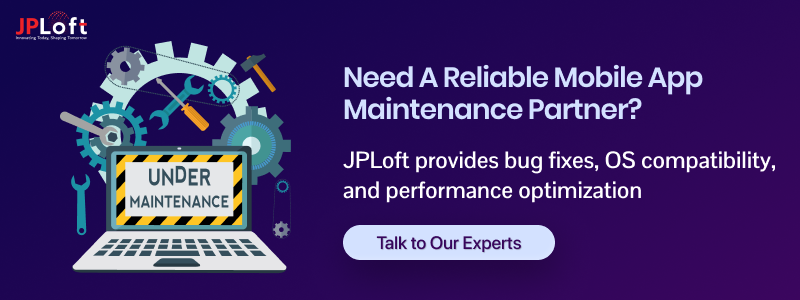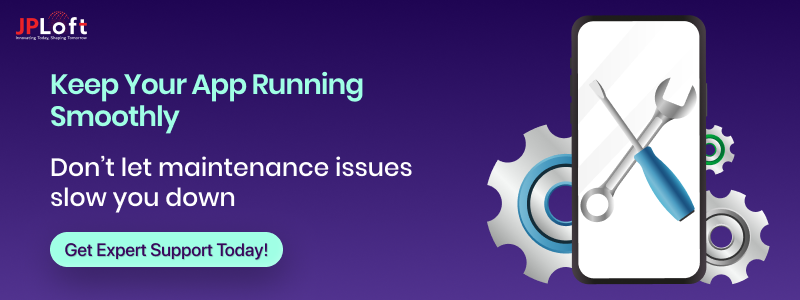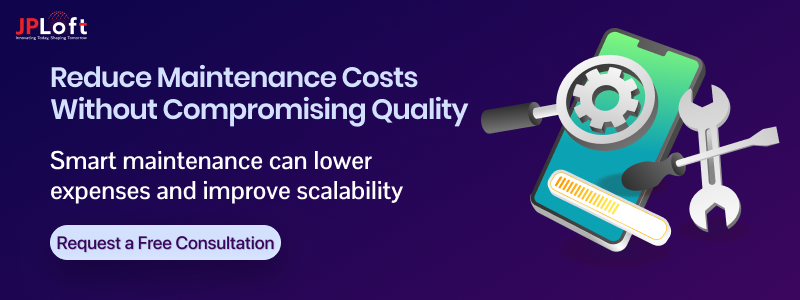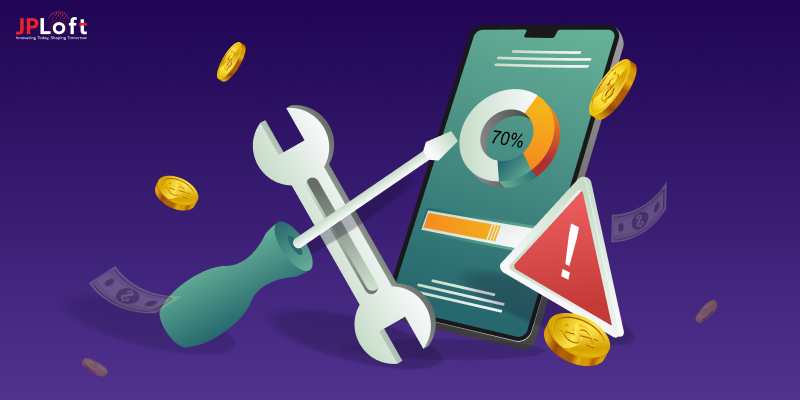Launching a mobile app is just the beginning.
Keeping it bug-free, fast, and secure is where the real challenge begins.
Without mobile app maintenance, even the best apps can face crashes, performance issues, and security threats, leading to loss of users and revenue.
Think about it, would you continue using an app that constantly lags or crashes?
Probably not.
Regular updates and maintenance keep an app running smoothly, ensuring a seamless user experience while meeting the latest security and OS requirements.
Why Does Mobile App Maintenance Matter?
- 53% of users abandon an app if it takes more than 3 seconds to load.
- Over 40% of cyberattacks target mobile applications with outdated security.
- 90% of users stop using an app due to performance issues.
Ignoring app maintenance services can lead to compatibility issues with new devices and operating systems, increased downtime, and expensive last-minute fixes.
Instead of waiting for things to break, a proactive mobile app maintenance plan saves time, money, and your brand’s reputation.
Here’s our the ultimate guide to mobile app maintenance.
What is Mobile App Maintenance?
Mobile app maintenance is the process of keeping an app updated, secure, and fully functional after its launch.
This is something that begins post mobile app development.
It involves regular bug fixes, security updates, performance optimizations, and feature enhancements to ensure a smooth user experience.
Many businesses assume that once an app is live, the work is done.
But in reality, the digital landscape evolves rapidly, and apps must adapt to stay relevant.
Regular app maintenance services help apps remain compatible with new operating system updates, device models, and third-party integrations.
What Does Mobile App Maintenance Include?
- Bug Fixes & Error Resolution: Addressing crashes, glitches, and performance issues.
- Security Updates & Compliance Checks: Preventing data breaches and ensuring legal compliance.
- Performance Optimization: Improving speed, responsiveness, and load times.
- UI/UX Enhancements: Updating design elements for better usability.
- Third-Party API & Integration Updates: Ensuring external services function smoothly
- New Feature Implementations: Adding functionalities to meet evolving user needs.
- iOS & Device Compatibility Updates: Adjusting the app to work seamlessly with iOS and Android updates.
Ignoring mobile app support and maintenance can result in security vulnerabilities, user dissatisfaction, and declining app performance, leading to uninstalls and negative reviews.
Now that we’ve covered the fundamentals, let’s explore why mobile app maintenance is important and how it impacts long-term success in next section of the app maintenance guide.
Why is Mobile App Maintenance Important?
An app that is not maintained regularly will quickly become outdated, vulnerable to security risks, and frustrating for users.
Businesses that invest in mobile app maintenance services ensure their app remains functional, secure, and aligned with evolving user expectations.
1. Improves Security and Compliance
Cyber threats are increasing, and apps without regular app security updates are at high risk of breaches.
Regular maintenance ensures compliance with regulations like GDPR and HIPAA while keeping user data secure.
Security patches, encryption updates, and vulnerability assessments help prevent data leaks and unauthorized access.
2. Enhances Performance and Speed
Slow-loading apps, frequent crashes, and lagging features lead to poor user retention.
Regular maintenance helps identify performance bottlenecks, optimize database queries, and improve server response times.
This ensures a smooth experience, reducing app abandonment rates.
3. Ensures Compatibility with New Devices and OS Updates
Operating systems like iOS and Android release frequent updates, and new devices enter the market regularly.
Apps that are not updated may become incompatible, leading to functionality issues.
Maintenance ensures the app works seamlessly across all devices and platforms.
4. Improves User Experience and Retention
Users expect intuitive navigation, fast load times, and bug-free interactions.
Regular updates based on user feedback help enhance the interface, fix usability issues, and introduce new features that improve engagement and retention.
5. Reduces Long-Term Costs
There are various cost apart from the biggest and major one i.e. mobile app development cost.
Fixing a major issue after it has caused system failures or data loss is significantly more expensive than preventing it in the first place.
Routine maintenance prevents costly emergency fixes by identifying and resolving issues early.
A proactive maintenance plan saves money and ensures uninterrupted business operations.
Understanding the importance of mobile app maintenance is the first step.
Next, we will explore different types of app maintenance and how they impact overall app performance.
Types of Mobile App Maintenance
App maintenance is not a one-size-fits-all process.
Different types of maintenance cater to different aspects of an app’s performance, security, and usability.
Understanding these types can help businesses plan a comprehensive mobile app maintenance strategy that keeps their app efficient, scalable, and aligned with user expectations.
► Corrective Maintenance – Fixing Bugs and Errors
No app is perfect at launch.
Users often encounter glitches, crashes, and functional issues that need immediate attention.
Corrective maintenance focuses on:
- Bug Fixes: Identifying and resolving software bugs affecting user experience.
- Crash Resolution: Addressing app crashes caused by faulty code or system conflicts.
- UI/UX Fixes: Resolving layout, navigation, or button responsiveness issues.
- API Failures: Fixing problems with third-party integrations like payment gateways, chat features, or social media logins.
- Data Loss Recovery: Restoring lost data due to system failures or database corruption.
Example: If users report that the app freezes when trying to upload images, corrective maintenance would involve debugging the issue, app testing solutions, and rolling out a patch to fix it.
► Adaptive Maintenance – Keeping Up with Industry Changes
Technology is constantly evolving.
Without adaptive maintenance, apps become outdated and incompatible with the latest industry standards.
Key areas covered:
- Operating System Updates: Ensuring compatibility with the latest iOS and Android versions.
- Device Compatibility: Adjusting the app for new smartphones, tablets, and foldable devices.
- Third-Party Integration Updates: Keeping APIs, SDKs, and plugins up to date to avoid failures.
- Legal and Compliance Changes: Adapting to new data protection laws like GDPR, CCPA, and HIPAA.
Example: When Apple introduces a new screen resolution or UI design requirement, adaptive maintenance ensures that the app adjusts smoothly to the change without breaking functionality.
► Perfective Maintenance – Improving User Experience and Features
User feedback plays a crucial role in shaping an app’s growth.
Perfective maintenance involves enhancing UI, performance, and features to improve usability and engagement.
Key improvements include:
- UI/UX Enhancements: Refining navigation, fonts, colors, and layouts for better usability.
- Feature Upgrades: Adding new functionalities to meet changing user needs.
- Performance Optimization: Improving app speed, reducing load times, and optimizing database queries.
- Code Optimization: Refactoring messy code to improve maintainability and scalability.
Example: If users complain about complicated checkout flows in an eCommerce app, perfective maintenance would involve redesigning the checkout process to be faster, simpler, and more intuitive.
► Preventive Maintenance – Proactively Avoiding Future Issues
Rather than waiting for a problem to occur, preventive maintenance identifies and eliminates potential risks before they impact users.
Key actions include:
- Security Patches: Regular updates to protect against cyber threats like hacking and malware.
- Log Monitoring and Error Detection: Analyzing system logs to detect and resolve minor issues before they escalate.
- Performance Audits: Assessing app speed, responsiveness, and stability to maintain high performance.
- Backup and Disaster Recovery Plans: Creating fail-safe mechanisms to prevent data loss and ensure quick recovery.
Example: A banking app might implement preventive security updates to defend against emerging cybersecurity threats, protecting sensitive financial data.
► Emergency Maintenance – Rapid Fixes for Unexpected Failures
Sometimes, critical issues arise without warning, affecting a large number of users. Emergency maintenance provides immediate fixes for major failures.
Situations that require emergency maintenance:
- Server Downtime: If the app’s backend crashes, users may be unable to access services.
- Security Breaches: Immediate action to fix data leaks or hacking attempts.
- Major Functional Breakdowns: Fixing sudden app failures that prevent users from completing key actions.
Example: If a ride-hailing app crashes on a high-traffic day like New Year’s Eve, emergency maintenance would involve deploying a quick patch to restore service instantly.
Now that we have covered the different types of mobile app maintenance, the next step is to create a detailed maintenance checklist to ensure that your app stays updated, secure, and fully functional.
Mobile App Maintenance Checklist
A structured mobile app maintenance plan ensures your app remains secure, high-performing, and aligned with user expectations.
Here’s a detailed checklist covering all critical aspects of app upkeep.
A] Bug Fixes and Performance Monitoring
Regular bug fixes keep an app stable and reliable. Performance monitoring helps identify slow load times, crashes, and lagging features before they become serious problems.
- Identify and resolve reported bugs from user feedback and crash reports.
- Monitor app speed, responsiveness, and loading times.
- Check for memory leaks and excessive CPU usage.
- Conduct stress testing to analyze how the app handles high traffic.
- Optimize database queries and background processes.
Example: If an eCommerce app frequently crashes during checkout, identifying the root cause and deploying a bug fix ensures users can complete purchases smoothly.
B] Security Updates and Compliance Checks
Cyber threats evolve daily. Regular security audits and updates are crucial to protect user data and transactions.
- Apply security patches to prevent vulnerabilities.
- Encrypt user data to comply with GDPR, HIPAA, or CCPA regulations.
- Regularly update firewalls and authentication protocols.
- Perform penetration testing to identify weak spots in the app.
- Monitor for unauthorized access or suspicious activity.
Example: A fintech app that stores sensitive financial data must undergo frequent security updates and compliance checks to avoid breaches.
C] Third-Party API and Integration Maintenance
Most apps rely on third-party services like payment gateways, cloud storage, and analytics tools. Outdated APIs can cause failures or compatibility issues.
- Check for API version updates and ensure seamless integration.
- Remove deprecated APIs that may affect app performance.
- Test payment gateways and subscription models for proper transaction processing.
- Ensure third-party authentication services like Google, Facebook, or Apple login are functional.
- Monitor external server downtime that may impact your app.
Example: If a ride-hailing app’s Google Maps integration stops working, users won’t be able to book rides, leading to revenue loss.
D] UI/UX Enhancements Based on User Feedback
User expectations change over time. Updating your app’s interface, design, and navigation improves engagement and retention.
- Analyze user reviews and identify pain points.
- Update UI components, fonts, colors, and layouts for better readability.
- Optimize navigation to reduce unnecessary steps in common actions.
- A/B test new designs and features before full implementation.
- Ensure accessibility features like voice commands and screen readers function properly.
Example: A food delivery app may need to redesign its menu layout to make food categories easier to browse, reducing user frustration.
E] OS and Device Compatibility Updates
Operating systems and hardware change frequently. If an app isn’t updated for new iOS and Android versions, it may stop working properly.
Test the app on the latest iOS and Android versions.
- Ensure compatibility with new smartphone models, tablets, and foldable devices.
- Update screen resolutions, touch gestures, and animations as needed.
- Optimize for wearables, smart TVs, and voice assistants if applicable.
- Remove or replace deprecated system functions that may cause crashes.
Example: When Apple releases a new iPhone with a different screen size, apps need adjustments to prevent display errors and usability issues.
F] Feature Enhancements and New Functionality Updates
Apps need to evolve to stay relevant and competitive. Adding new features keeps users engaged and prevents churn.
- Track industry trends and assess whether new features are needed.
- Implement features based on user demand and competitor analysis.
- Improve push notifications, chat features, or AI-driven recommendations.
- Update voice search, AR, or AI-based functionalities if applicable.
- Conduct beta testing before rolling out new features.
Example: A fitness app might add AI-powered workout recommendations to improve personalization and user engagement.
G] App Store Optimization (ASO) and Content Updates
Regular updates to app descriptions, keywords, and promotional materials boost search rankings on app stores.
- Update the App Store and Google Play descriptions with relevant keywords.
- Refresh screenshots, preview videos, and promotional banners.
- Improve app onboarding flows to reduce drop-offs.
- Check for policy changes in Google Play and App Store guidelines.
- Monitor competitor updates and adjust ASO strategies accordingly.
Example: A travel booking app may update its store listings with seasonal offers, attracting more users during peak travel periods.
H] Regular Data Backup and Recovery Planning
Data loss can occur due to server crashes, accidental deletions, or cyberattacks. A strong backup plan prevents permanent damage.
- Schedule automated daily or weekly backups.
- Store backups on secure cloud storage with encryption.
- Set up disaster recovery protocols to restore data quickly.
- Test backup systems regularly to ensure reliability.
- Keep separate backups for user data, transactions, and logs.
Example: An e-learning app with thousands of video courses must back up user progress data, preventing data loss if a system failure occurs.
I] Monitoring App Performance Metrics and Analytics
Tracking app performance helps identify weak points and opportunities for improvement.
- Monitor app loading times, crashes, and error logs.
- Track active users, session duration, and retention rates.
- Analyze heatmaps and user behavior flow to detect usability issues.
- Measure conversion rates on key actions like purchases or sign-ups.
- Identify drop-off points in onboarding or checkout flows.
Example: A subscription-based app may notice a high drop-off rate during payment, signaling a need to streamline checkout processes.
J] Reducing App Maintenance Costs Without Compromising Quality
Smart strategies can cut down expenses while ensuring consistent maintenance.
- Use automated testing tools to detect issues early.
- Optimize cloud hosting and server resources to reduce costs.
- Remove unused features or functions that increase maintenance workload.
- Plan maintenance in stages instead of reactive fixes.
- Outsource maintenance tasks to a mobile app maintenance company for cost-efficient support.
Example: An on-demand service app can save costs by automating user issue detection through AI-driven chatbots instead of relying on manual customer support.
A well-maintained app keeps users happy, improves performance, and reduces security risks.
Now that we have covered the mobile app maintenance checklist, next we will explore how much mobile app maintenance costs and what factors influence pricing.
How to Choose the Right Mobile App Maintenance Service?
Selecting the right mobile app maintenance company is crucial to ensuring long-term app stability, security, and performance.
The wrong choice can lead to frequent downtime, security vulnerabilities, and unnecessary costs.
Here’s what to consider when choosing an app maintenance service.
1. Experience and Industry Expertise
Not all apps have the same maintenance needs. A healthcare app requires strict compliance, while a gaming app needs real-time performance monitoring.
What to look for:
- A portfolio of maintained apps in your industry
- Experience in handling security, scalability, and compliance issues
- Ability to manage both native (iOS, Android) and cross-platform apps
Example: A fintech app handling sensitive transactions must work with a maintenance provider experienced in PCI DSS compliance and financial-grade security.
2. 24/7 Monitoring and Support
Issues don’t always occur during business hours. A critical bug or security breach could happen at any time, requiring immediate action.
What to check:
- Does the company offer round-the-clock support?
- What is the average response time for urgent fixes?
- Are there dedicated support plans for emergency situations?
Example: An eCommerce app experiencing downtime during Black Friday sales needs an immediate resolution, making 24/7 support essential.
3. Security and Compliance Management
Security vulnerabilities can damage brand reputation and lead to legal issues. Ensuring that a maintenance service prioritizes security is non-negotiable.
Key security factors:
- Regular security audits and vulnerability patching
- Compliance with GDPR, HIPAA, CCPA, or PCI DSS standards
- Implementation of data encryption, firewalls, and access control
Example: A telemedicine app must comply with HIPAA regulations to protect patient data, requiring maintenance services with healthcare security expertise.
4. Scalability and Future-Proofing
A good maintenance provider doesn’t just fix problems, they help apps adapt and scale as businesses grow.
What to consider:
- Can the company handle increasing traffic and feature expansions?
- Do they provide cloud optimization and database management?
- Are they skilled in emerging technologies like AI, AR, and blockchain?
Example: A ride-hailing app expanding to new cities and users needs a maintenance provider that can scale backend infrastructure and optimize cloud performance.
5. Transparent Pricing and Flexible Plans
Hidden fees can lead to unexpected maintenance costs. A reliable provider offers clear pricing models without unnecessary charges.
What to evaluate:
- Do they provide fixed-price, hourly, or subscription-based plans?
- Are bug fixes, updates, and security patches included in the contract?
- Is there a scalability clause for future enhancements?
|
Pricing Model |
Best For |
Considerations |
|
Fixed-price |
Small, well-defined updates |
Limited scope, may not cover ongoing fixes |
|
Hourly billing |
Custom bug fixes and feature updates |
Costs vary based on work volume |
|
Subscription plans |
Ongoing maintenance and security |
Predictable monthly costs |
Example: A subscription-based fitness app may benefit from a monthly maintenance plan that includes regular updates, bug fixes, and server monitoring.
6. Tech Stack and Compatibility
A maintenance provider must be well-versed in the app’s development technology to ensure seamless updates.
What to check:
- Experience with native app frameworks (Swift, Kotlin) and cross-platform tools (Flutter, React Native)
- Familiarity with backend technologies (Node.js, Python, PHP, Ruby on Rails)
- Knowledge of database management (PostgreSQL, Firebase, MongoDB)
Example: A food delivery app built on Flutter with Firebase backend requires a maintenance service skilled in both technologies to avoid integration issues.
7. Performance Optimization Strategies
A good maintenance partner focuses on continuous performance improvements rather than just fixing problems.
What they should offer:
- Regular load testing to prevent crashes during peak usage
- App size and speed optimization for better user experience
- Real-time error tracking and performance analytics
Example: A video streaming app requires ongoing content delivery network (CDN) optimizations to ensure smooth playback without buffering issues.
8. User Experience and Feature Enhancements
User expectations evolve, and a maintenance provider should help refine app usability and introduce new features.
What they should provide:
- Data-driven UI/UX recommendations based on user behavior
- A/B testing for new features before full rollout
- Accessibility improvements to meet global usability standards
Example: A social networking app may introduce new messaging features or improve navigation based on heatmap analytics provided by a proactive maintenance partner.
Making the Right Choice
Selecting the right mobile app maintenance partner requires evaluating experience, security focus, scalability, pricing transparency, and ongoing support capabilities.
Key Questions to Ask Before Hiring:
- How many years of experience do you have in app maintenance?
- Can you provide case studies or references from previous clients?
- What security measures and compliance protocols do you follow?
- Do you offer 24/7 support and emergency bug fixes?
- How do you handle performance monitoring and feature updates?
- What pricing model do you offer, and what’s included in the plan?
With the right mobile app maintenance service, businesses can ensure long-term success, better user engagement, and lower operational risks. And with this, we have come to the end of the complete guide to mobile app maintenance.
How JPLoft Can Help You Maintain Your Mobile App
JPLoft offers comprehensive mobile app maintenance services to ensure your app remains secure, high-performing, and up to date.
As a leading mobile app maintenance company, we provides bug fixes, performance optimization, security updates, and OS compatibility adjustments to prevent downtime and enhance user experience.
We handle compliance with GDPR, HIPAA, and PCI DSS, ensuring data security and regulatory adherence.
Our cost-effective maintenance plans include UI/UX enhancements, third-party API updates, and cloud optimization to keep your app scalable.
Partner with JPLoft for reliable mobile app maintenance and future-proof your business. Contact us today to get a customized maintenance plan.
Conclusion
Mobile app maintenance is not just about fixing bugs, it’s about ensuring long-term success, security, and optimal performance. Without regular updates, an app can quickly become outdated, leading to downtime, security risks, and poor user retention.
A well-maintained app stays compatible with new OS updates, scales with user demand, and adapts to evolving business needs. Investing in proactive mobile app maintenance saves money in the long run and keeps users engaged.
Partnering with a reliable mobile app maintenance company like JPLoft ensures that your app remains fast, secure, and future-ready. Plan ahead, optimize costs, and keep your app running smoothly.
FAQs
Apps should be updated at least every 2-3 months for security patches, bug fixes, and feature enhancements. Major updates should align with iOS and Android OS releases to ensure compatibility.
The cost depends on app complexity, third-party integrations, and security requirements. On average, businesses spend $5,000 – $50,000 per year, with larger apps requiring higher maintenance budgets.
Without maintenance, an app becomes slow, vulnerable to security breaches, and incompatible with new devices. This leads to poor user experience, increased uninstalls, and potential revenue loss.
Yes. Regular maintenance prevents major technical failures, security breaches, and costly emergency fixes, ensuring lower long-term operational expenses.
Look for a provider with industry experience, 24/7 support, strong security protocols, and scalable solutions. A transparent pricing model and proactive maintenance approach are also crucial.













Share this blog